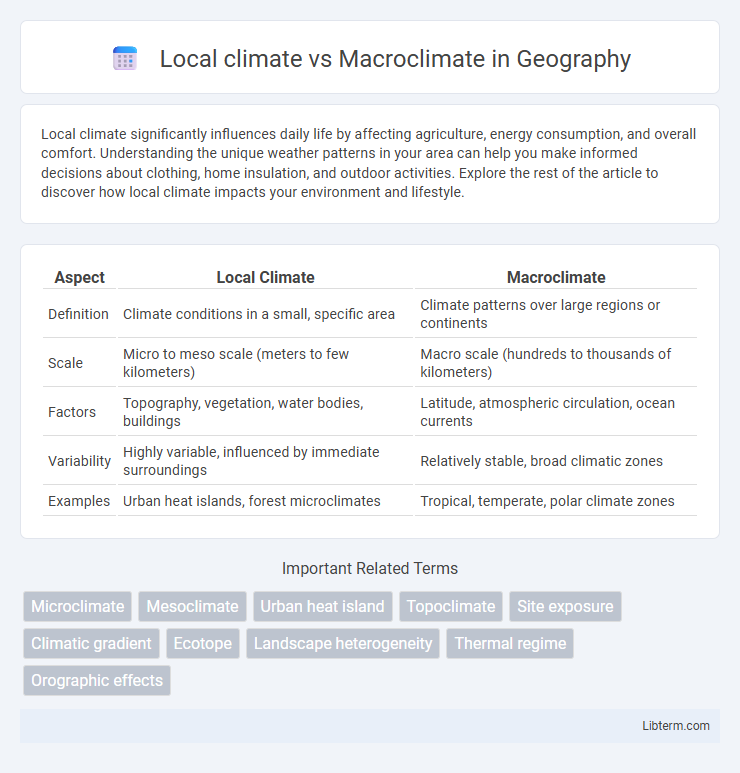Local climate significantly influences daily life by affecting agriculture, energy consumption, and overall comfort. Understanding the unique weather patterns in your area can help you make informed decisions about clothing, home insulation, and outdoor activities. Explore the rest of the article to discover how local climate impacts your environment and lifestyle.
Table of Comparison
| Aspect | Local Climate | Macroclimate |
|---|---|---|
| Definition | Climate conditions in a small, specific area | Climate patterns over large regions or continents |
| Scale | Micro to meso scale (meters to few kilometers) | Macro scale (hundreds to thousands of kilometers) |
| Factors | Topography, vegetation, water bodies, buildings | Latitude, atmospheric circulation, ocean currents |
| Variability | Highly variable, influenced by immediate surroundings | Relatively stable, broad climatic zones |
| Examples | Urban heat islands, forest microclimates | Tropical, temperate, polar climate zones |
Understanding Local Climate: Definition and Significance
Local climate refers to the specific atmospheric conditions and weather patterns experienced in a small, defined area, influenced by factors such as topography, vegetation, urbanization, and water bodies. It differs from macroclimate, which encompasses broader regional weather trends and climatic zones over extensive geographic areas. Understanding local climate is crucial for urban planning, agriculture, and biodiversity conservation, as it directly affects microenvironments and the immediate living conditions of plant, animal, and human populations.
What is Macroclimate? Key Characteristics
Macroclimate refers to the general climate conditions of a large geographic area, such as a region or continent, influencing temperature, precipitation, and seasonal patterns over broad scales. Key characteristics of macroclimate include its extensive spatial range, stability over time, and its role in shaping ecosystems and weather trends within its boundaries. Macroclimate contrasts with local climate by encompassing wider atmospheric conditions rather than micro-scale environmental variations.
Key Differences Between Local Climate and Macroclimate
Local climate refers to the atmospheric conditions experienced in a specific, small area such as a valley, urban neighborhood, or forest, characterized by microclimatic factors like shading, elevation, and surface materials. Macroclimate encompasses broader regional climate patterns influenced by large-scale atmospheric circulation, geographic location, and topography, typically covering areas such as states, countries, or continents. Key differences include scale, with local climate affecting precise locations and microhabitats, and macroclimate describing general climate zones and long-term weather trends over extensive territories.
Factors Influencing Local Climates
Local climates are shaped by factors such as topography, vegetation, water bodies, and urban development, which create distinct microclimates within broader regional patterns. Elevation affects temperature and precipitation, while proximity to oceans or lakes moderates climate by influencing humidity and heat retention. Urban areas often generate heat islands due to concrete surfaces and reduced vegetation, leading to warmer local temperatures compared to surrounding natural landscapes.
Macroclimate Patterns and Regional Impacts
Macroclimate patterns refer to large-scale atmospheric conditions and climate zones that span extensive geographic areas, influencing temperature, precipitation, and wind over regions or continents. These patterns, such as ocean currents, prevailing westerlies, and the Intertropical Convergence Zone, drive regional climate variations and affect ecosystems, agriculture, and urban planning. Understanding macroclimate allows for predicting broad climate trends and their impacts on regional water resources, biodiversity, and socioeconomic activities.
Local Climate Variations: Urban vs Rural Areas
Local climate variations between urban and rural areas are primarily influenced by the urban heat island effect, where cities experience higher temperatures due to dense infrastructure, reduced vegetation, and heat retention by buildings and pavement. Rural areas typically maintain cooler temperatures with more natural vegetation, open land, and higher evapotranspiration rates that moderate local climate conditions. These differences impact energy consumption, air quality, and local weather patterns, making urban microclimates significantly distinct from surrounding rural macroclimates.
The Role of Geography in Shaping Macroclimate
Geography significantly influences macroclimate by determining large-scale atmospheric patterns through features such as latitude, altitude, and proximity to oceans. Mountain ranges affect air flow and precipitation distribution, creating distinct climate zones across regions. Ocean currents and continental landmasses further shape temperature and humidity, establishing characteristic macroclimates over extensive geographical areas.
How Local and Macroclimates Affect Agriculture
Local climate, characterized by microclimates within specific fields or farmsteads, influences agriculture by affecting soil moisture, temperature, and pest populations at a granular level, enabling farmers to optimize crop selection and management practices. Macroclimate, encompassing broader regional weather patterns such as average rainfall and seasonal temperatures, dictates the overall suitability of an area for certain crops and influences planting schedules and long-term agricultural planning. Understanding the interaction between local and macroclimates allows for precision agriculture that maximizes yield while mitigating risks from climate variability.
Climate Change: Effects on Local and Macroclimate Scales
Climate change impacts both local climate and macroclimate scales by altering temperature patterns, precipitation levels, and extreme weather events. Local climates experience microenvironment shifts driven by urbanization and deforestation, intensifying effects such as heat islands and altered local hydrology. Macroclimate changes influence global atmospheric circulation and ocean currents, exacerbating long-term regional climate variability and ecosystem disruptions.
Strategies for Adapting to Local and Macroclimate Changes
Strategies for adapting to local and macroclimate changes involve tailored approaches that address the specific conditions of microenvironments and broader regional climates. Implementing urban green spaces and reflective building materials can mitigate local heat islands, while large-scale renewable energy adoption and regional water resource management tackle macroclimate challenges. Climate-resilient infrastructure and community-based adaptation plans optimize responses to varied climatic impacts across different spatial scales.
Local climate Infographic

 libterm.com
libterm.com